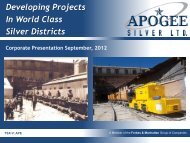Pulacayo Project Feasibility Study - Apogee Silver
Pulacayo Project Feasibility Study - Apogee Silver
Pulacayo Project Feasibility Study - Apogee Silver
You also want an ePaper? Increase the reach of your titles
YUMPU automatically turns print PDFs into web optimized ePapers that Google loves.
<strong>Pulacayo</strong> 1 000 t/d Phase I <strong>Feasibility</strong> <strong>Study</strong> - NI 43-101 Technical Report<br />
090644-3-0000-20-IFI-100<br />
Historically, quality differentiation in the lead concentrate market was largely addressed by the<br />
smelters through the imposition of penalties (as it continues to be with zinc and copper) and,<br />
occasionally, adjustments to payable metals. China’s expanded influence however, has had a<br />
notable effect on the market, particularly for high silver-bearing lead concentrates, which are not<br />
well suited to Chinese smelters for the following reasons:<br />
<br />
<br />
17% VAT on silver bearing lead concentrate imports<br />
No VAT rebate on silver metal exports<br />
<br />
Negative London/Shanghai silver price differential<br />
Combined, these three factors have resulted in a negative arbitrage in the silver price, which is<br />
currently in the order of USD 4 to 5/oz.<br />
As a consequence of changing dynamics, today’s lead concentrate market can effectively be<br />
segregated into three sub-categories:<br />
1) Clean, high grade (+/-60% Pb) concentrates (e.g. Doe Run/Missouri)<br />
2) Medium-grade (+/- 50% Pb), complex concentrates (e.g. Red Dog)<br />
3) Complex, high precious metal bearing concentrates (e.g. Cannington, San Cristobal,<br />
various Peruvian/Mexican, Greens Creek)<br />
With precious metal prices and, in particular, silver prices projected to remain strong, the greatest<br />
growth in output of lead concentrates is expected to be seen in the latter complex, high precious<br />
metal bearing category, although the expected closure of Doe Run’s Herculaneum, Missouri<br />
smelter at the end of 2013 can be expected to free up some 120,000 tons of contained lead in<br />
clean concentrates (approximately 200,000 tons concentrates). While declining silver prices have<br />
somewhat supported the economics of importing silver-bearing concentrate into China, the<br />
decline has been nowhere near adequate to offset the effect of Chinese tax policies and the<br />
continuing, although narrowing, negative London/Shanghai silver arb noted above. Nonetheless,<br />
unless and until regulatory and tax policy changes are forthcoming in China, these qualities will<br />
remain best suited to western smelters, the result of which may be an ongoing smelter<br />
‘bottleneck’ for such materials.<br />
As with the zinc and copper markets, annual contract negotiations take place between the major<br />
miners (e.g. Cannington, San Cristobal, Red Dog, etc.) and western smelters in late- Q4/early Q1<br />
of each year and such settlements typically set a frame of reference for other market<br />
transactions. However, unlike these other markets, as a result of the aforementioned market<br />
segregation in lead, there is no longer any single identifiable lead benchmark, with mines and<br />
smelters agreeing terms (treatment charges, escalators/de-escalators, if any, and silver refining<br />
charges) based on the specific characteristics of the individual concentrates (notably silver levels)<br />
and the market outlooks and objectives of the individual players involved in the discussions.<br />
Historically refining charges for silver in lead concentrates of USD 0.30 to 0.35 per payable ounce<br />
were standard in the market. However, as western smelting capacity migrated to China and new<br />
high silver mines such as San Cristobal and Penasquito came into production, the<br />
aforementioned bottleneck for higher silver lead concentrate emerged due to the Chinese<br />
limitations. This was amplified with the 2009 closure of Doe Run’s La Oroya, Peru lead smelter, a<br />
facility specialized in the treatment of complex concentrates. As a result, silver refining charges<br />
jumped from the USD 0.30 to USD 0.35 per payable ounce level to USD 0.50 per payable ounce<br />
TWP Sudamérica S.A. Av. Encalada 1257 Of. 801, Santiago de Surco Lima 33, Perú (51-1) 4377473<br />
Page 221



